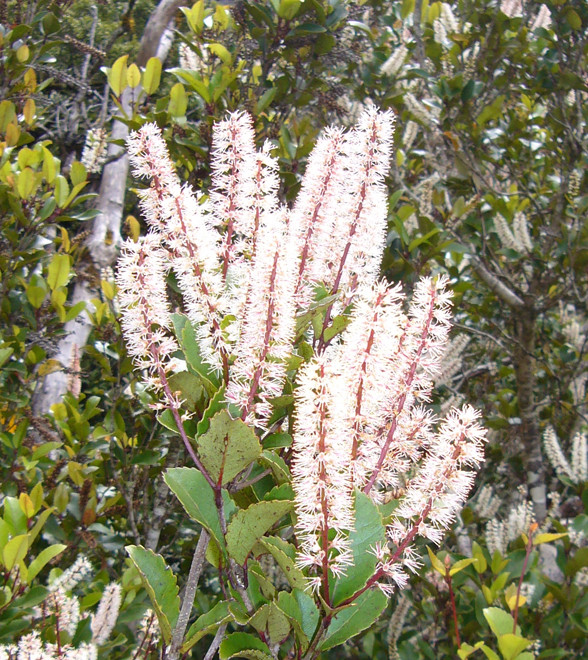IV. Rata and Kamahi
Tree rātā belong to the Myrtle family (Myrtaceae), a large family of flowering plants that includes pōhutukawa (Metrosideros excelsa), gum trees, feijoa, guava, clove and allspice. New Zealand has 19 species in this family:
- trees: rātā species, pōhutukawa, kānuka, swamp maire
- shrubs: mānuka, rōhutu, ramarama
- vines: six species of climbing rātā.
The Southern Rata (Metrosideros umbellata)
Etymology: Metrosideros = 'iron-hearted' due to the strength of the wood and
umbellata = the way the flowers grow as an umbrella shaped group of flowers originating from a single stem.
It does not grow as tall as northern rātā, usually only reaching 15 metres. It is widespread in the western South Island, on Stewart Island, and on the coastal edge of the Auckland Islands. In the North Island, it grows on the high peaks of Northland and Coromandel.
Southern rātā tolerates most soil types, including the limestone and toxic soils around Nelson.It is easily distinguished from the other tree rātā by its shiny leaves, which have many oil glands and a pointed tip.
The Southern Rata is a major source of honey and the nectar is important for birds like Kākā, tui, and bellbirds.
This forest type is under serious threat by the brushtail possum (Trichosurus vulpecula Kerr), originally introcuded into New Zealand from Australia in the 19th century.
For the last forty years canopy dieback has become an increasing problem due to the voracious appetite and invasion southwards of the possum (see Magnitude of Canopy Dieback).
Introduced chamois (Rupicapra rupicapra), now widespread in western forests, also threaten the regeneration of forests (see Distribution and diet of chamois).
Kamahi (Weinmannia racemosa)
Weinmannia racemosa is a medium-sized tree of the family Cunoniaceae, is a very common tree in New Zealand, occurring in lowland, montane, and subalpine forests and shrubland from the central North Island south to Stewart Island.
Weinmannia racemosa Is the dominant tree on Mt Egmont/Taranaki and that's unique as virtually all New Zealand mountains have beech trees as the dominate tree, Mt Egmont/Taranaki has none. The theory is the eruptions killed all the beech (see Terrain).







